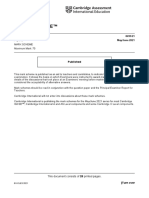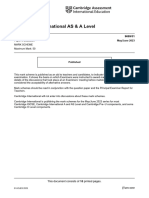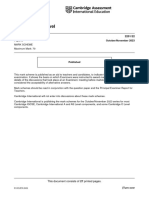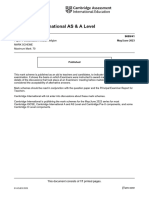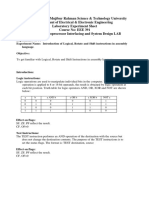Cambridge International AS & A Level: Sociology 9699/32 May/June 2021
Cambridge International AS & A Level: Sociology 9699/32 May/June 2021
Uploaded by
chemceptualwithfaizCopyright:
Available Formats
Cambridge International AS & A Level: Sociology 9699/32 May/June 2021
Cambridge International AS & A Level: Sociology 9699/32 May/June 2021
Uploaded by
chemceptualwithfaizOriginal Title
Copyright
Available Formats
Share this document
Did you find this document useful?
Is this content inappropriate?
Copyright:
Available Formats
Cambridge International AS & A Level: Sociology 9699/32 May/June 2021
Cambridge International AS & A Level: Sociology 9699/32 May/June 2021
Uploaded by
chemceptualwithfaizCopyright:
Available Formats
Cambridge International AS & A Level
SOCIOLOGY 9699/32
Paper 3 Education May/June 2021
MARK SCHEME
Maximum Mark: 50
Published
This mark scheme is published as an aid to teachers and candidates, to indicate the requirements of the
examination. It shows the basis on which Examiners were instructed to award marks. It does not indicate the
details of the discussions that took place at an Examiners’ meeting before marking began, which would have
considered the acceptability of alternative answers.
Mark schemes should be read in conjunction with the question paper and the Principal Examiner Report for
Teachers.
Cambridge International will not enter into discussions about these mark schemes.
Cambridge International is publishing the mark schemes for the May/June 2021 series for most Cambridge
IGCSE™, Cambridge International A and AS Level components and some Cambridge O Level components.
This document consists of 9 printed pages.
© UCLES 2021 [Turn over
9699/32 Cambridge International AS & A Level – Mark Scheme May/June 2021
PUBLISHED
Generic Marking Principles
These general marking principles must be applied by all examiners when marking candidate answers.
They should be applied alongside the specific content of the mark scheme or generic level descriptors
for a question. Each question paper and mark scheme will also comply with these marking principles.
GENERIC MARKING PRINCIPLE 1:
Marks must be awarded in line with:
• the specific content of the mark scheme or the generic level descriptors for the question
• the specific skills defined in the mark scheme or in the generic level descriptors for the question
• the standard of response required by a candidate as exemplified by the standardisation scripts.
GENERIC MARKING PRINCIPLE 2:
Marks awarded are always whole marks (not half marks, or other fractions).
GENERIC MARKING PRINCIPLE 3:
Marks must be awarded positively:
• marks are awarded for correct/valid answers, as defined in the mark scheme. However, credit
is given for valid answers which go beyond the scope of the syllabus and mark scheme,
referring to your Team Leader as appropriate
• marks are awarded when candidates clearly demonstrate what they know and can do
• marks are not deducted for errors
• marks are not deducted for omissions
• answers should only be judged on the quality of spelling, punctuation and grammar when these
features are specifically assessed by the question as indicated by the mark scheme. The
meaning, however, should be unambiguous.
GENERIC MARKING PRINCIPLE 4:
Rules must be applied consistently, e.g. in situations where candidates have not followed
instructions or in the application of generic level descriptors.
GENERIC MARKING PRINCIPLE 5:
Marks should be awarded using the full range of marks defined in the mark scheme for the question
(however; the use of the full mark range may be limited according to the quality of the candidate
responses seen).
GENERIC MARKING PRINCIPLE 6:
Marks awarded are based solely on the requirements as defined in the mark scheme. Marks should
not be awarded with grade thresholds or grade descriptors in mind.
© UCLES 2021 Page 2 of 9
9699/32 Cambridge International AS & A Level – Mark Scheme May/June 2021
PUBLISHED
Social Science-Specific Marking Principles
(for point-based marking)
1 Components using point-based marking:
• Point marking is often used to reward knowledge, understanding and application of skills. We
give credit where the candidate’s answer shows relevant knowledge, understanding and
application of skills in answering the question. We do not give credit where the answer shows
confusion.
From this it follows that we:
(a) DO credit answers which are worded differently from the mark scheme if they clearly
convey the same meaning (unless the mark scheme requires a specific term)
(b) DO credit alternative answers/examples which are not written in the mark scheme if they
are correct
(c) DO credit answers where candidates give more than one correct answer in one
prompt/numbered/scaffolded space where extended writing is required rather than list-type
answers. For example, questions that require n reasons (e.g. State two reasons …).
(d) DO NOT credit answers simply for using a ‘key term’ unless that is all that is required.
(Check for evidence it is understood and not used wrongly.)
(e) DO NOT credit answers which are obviously self-contradicting or trying to cover all
possibilities
(f) DO NOT give further credit for what is effectively repetition of a correct point already
credited unless the language itself is being tested. This applies equally to ‘mirror
statements’ (i.e. polluted/not polluted).
(g) DO NOT require spellings to be correct, unless this is part of the test. However spellings of
syllabus terms must allow for clear and unambiguous separation from other syllabus terms
with which they may be confused (e.g. Corrasion/Corrosion)
2 Presentation of mark scheme:
• Slashes (/) or the word ‘or’ separate alternative ways of making the same point.
• Semi colons (;) bullet points (•) or figures in brackets (1) separate different points.
• Content in the answer column in brackets is for examiner information/context to clarify the
marking but is not required to earn the mark (except Accounting syllabuses where they indicate
negative numbers).
3 Calculation questions:
• The mark scheme will show the steps in the most likely correct method(s), the mark for each
step, the correct answer(s) and the mark for each answer
• If working/explanation is considered essential for full credit, this will be indicated in the question
paper and in the mark scheme. In all other instances, the correct answer to a calculation
should be given full credit, even if no supporting working is shown.
• Where the candidate uses a valid method which is not covered by the mark scheme, award
equivalent marks for reaching equivalent stages.
• Where an answer makes use of a candidate’s own incorrect figure from previous working, the
‘own figure rule’ applies: full marks will be given if a correct and complete method is used.
Further guidance will be included in the mark scheme where necessary and any exceptions to
this general principle will be noted.
© UCLES 2021 Page 3 of 9
9699/32 Cambridge International AS & A Level – Mark Scheme May/June 2021
PUBLISHED
4 Annotation:
• For point marking, ticks can be used to indicate correct answers and crosses can be used to
indicate wrong answers. There is no direct relationship between ticks and marks. Ticks have no
defined meaning for levels of response marking.
• For levels of response marking, the level awarded should be annotated on the script.
• Other annotations will be used by examiners as agreed during standardisation, and the
meaning will be understood by all examiners who marked that paper.
© UCLES 2021 Page 4 of 9
9699/32 Cambridge International AS & A Level – Mark Scheme May/June 2021
PUBLISHED
Question Answer Marks
1 Describe two examples of how anti-school subcultures can affect 4
educational attainment.
Indicative content
• Discourage achievement by teasing students who work hard.
• Getting expelled/excluded/dismissed from lessons.
• Disrupting lessons.
• Truanting / missing lessons.
• Members of anti-school subcultures may be labelled leading to a self-
fulfilling prophecy.
• Alternative goals to those promoted by education.
• Any other relevant example.
Note:
Reward a maximum of two examples. For each example up to 2 marks are
available:
1 mark for identifying an example of how anti-school subcultures can affect
educational attainment.
1 mark for showing understanding of how the example can affect educational
attainment.
(2 × 2 marks)
© UCLES 2021 Page 5 of 9
9699/32 Cambridge International AS & A Level – Mark Scheme May/June 2021
PUBLISHED
Question Answer Marks
2 Explain two ways in which girls’ educational performance may be 8
influenced by wider social changes.
Indicative content
• Changes in media images of men and women
• Feminism has challenged traditional stereotypes
• Changes in female aspirations
• Changes in employment opportunities, laws and flexibility.
• Changes in family structures, need for economic independence
• Any other relevant reason
Reward a maximum of two reasons. Up to 4 marks are available for each
reason
1 mark for making a point / identifying a reason (e.g. changes in media
images of men and women).
1 mark for explaining that point/identifying a reason (e.g. wider range of role
models for girls)
1 mark for selecting relevant sociological material such as a
study/concept/theory/empirical evidence to support the point (e.g. McRobbie)
1 mark for explaining how the material supports the point (e.g. McRobbie
found increasing portrayal of women aspiring to successful careers rather
than just romance and marriage).
(2 × 4 marks)
© UCLES 2021 Page 6 of 9
9699/32 Cambridge International AS & A Level – Mark Scheme May/June 2021
PUBLISHED
Question Answer Marks
3 ‘The school curriculum gives all pupils an equal chance to fulfil their 12
educational potential’.
Using sociological material, give two arguments against this view.
Indicative content
• Ethnocentric curriculum may disadvantage some ethnic minorities.
• Feminised curriculum may disadvantage boys.
• Lack of female representation in some subjects may disadvantage girls.
• Dominance of middle-class culture in the curriculum may disadvantage
working class pupils.
• Disjuncture of linguistic code/cultural capital/habitus reduces
ability/motivation of some to engage with curriculum
• Any other relevant argument against the view
Reward a maximum of two arguments. Up to 6 marks are available for each
argument.
Note:
This question is asking for arguments against the view. There are no marks
for explaining the view or giving arguments supporting the view.
Levels of response
Use the following levels to mark each argument.
Level 3: 5–6 marks
• One clear and developed argument against the view that the school
curriculum equally helps children of all backgrounds to reach their
potential
• Sociological material, such as concepts, theories and evidence, is used
to support the argument against the view. The material selected is
appropriate and focused on the question with its relevance made clear.
Level 2: 3–4 marks
• One clear but underdeveloped argument against the view that the school
curriculum equally helps children of all backgrounds to reach their
potential
• The material selected is appropriate but not fully focused on the
question. Sociological evidence is used but its relevance to the argument
is not made clear.
Level 1: 1–2 marks
• One point disagreeing with the view that the school curriculum equally
helps children of all backgrounds to reach their potential
which is undeveloped or lacking clarity.
• Any material selected lacks focus on the specific question.
Level 0: 0 marks
No response worthy of credit.
© UCLES 2021 Page 7 of 9
9699/32 Cambridge International AS & A Level – Mark Scheme May/June 2021
PUBLISHED
Question Answer Marks
4 Evaluate the view that education is an instrument of ideological control. 26
Indicative content
In support Against
Points • Marxist model of society • Functionalist model of
• Althusser – ideological social cohesion and role-
state apparatus allocation
• Bowles and Gintis – • Social Democratic and
correspondence theory liberal perspectives on
• Bourdieu – cultural economic progress and
reproduction individual opportunity
• Willis – learning to labour • Interactionist perspective
• Feminist perspective – on teacher and pupils’
patriarchy definitions of the
• Ethnocentric curriculum situation and human
and racism agency
• Young - Social • Postmodernism and
Construction of cultural diversity
knowledge
Evidence Bowles and Gintis, Chitty,
Bates and Riseborough, Saunders,
Davies, Chubb and Moe,
Willis, Willis,
Kampmeier, Fuller
Gillborn
Concepts Class conflict Function,
Infrastructure, Consensus,
Proletariat, Social Mobility,
Correspondence theory, Subjective meaning,
Cultural capital, Subculture
Hidden curriculum
The above content is indicative and other relevant approaches to the
question should be rewarded appropriately.
© UCLES 2021 Page 8 of 9
9699/32 Cambridge International AS & A Level – Mark Scheme May/June 2021
PUBLISHED
Question 4 levels of response
Levels of response
Level 5: 22–26 marks
• Very good knowledge and understanding of the view that education is an instrument of ideological
control. The response contains a wide range of detailed points with very good use of concepts
and theory/research evidence.
• The material selected will be accurately interpreted, well developed and consistently applied to
answering the question.
• Clear and sustained analysis with detailed and explicit evaluation of the view that education is an
instrument of ideological control.
Level 4: 17–21 marks
• Good knowledge and understanding of the view that education is an instrument of ideological
control. The response contains a range of detailed points with good use of concepts and
theory/research evidence.
• The material selected will be accurate and relevant but not always consistently applied to
answering the question.
• Good analysis/evaluation of the view that education is an instrument of ideological control. This
may be explicit and direct but not sustained, or it will rely on a good account of different views on
the role of education.
Level 3: 11–16 marks
• Reasonable knowledge and understanding of the view that education is an instrument of
ideological control. The response contains a narrow range of detailed points or a wider range of
underdeveloped points, with some use of concepts or theory or research evidence.
• The material selected will be largely appropriate but its relevance to the question may be unclear
or confused at times.
• Some analysis/evaluation of the view that education is an instrument of ideological control. This
may be one point explicitly used to argue for or against the view that education is an instrument of
ideological control or a simple descriptive account of different views on the role of education.
Level 2: 6–10 marks
• Basic knowledge and understanding of the view that education is an instrument of ideological
control. The response contains a narrow range of underdeveloped points and may include basic
references to concepts or theories or research evidence.
• The material selected is relevant to the topic but lacks focus on or relevance to the specific
question.
• Any analysis or evaluation is likely to be incidental, confused or simply assertive.
Level 1: 1–5 marks
• Limited knowledge and understanding of the view that education is an instrument of ideological
control. The response contains only assertive points or common-sense observations.
• There is little or no application of sociological material.
• Little or no relevant analysis or evaluation.
Level 0: 0 marks
No response worthy of credit.
© UCLES 2021 Page 9 of 9
You might also like
- Cambridge International AS & A Level: Sociology 9699/33 May/June 2021Document9 pagesCambridge International AS & A Level: Sociology 9699/33 May/June 2021Trang MinhNo ratings yet
- Cambridge International AS & A Level: Sociology 9699/13 May/June 2021Document13 pagesCambridge International AS & A Level: Sociology 9699/13 May/June 2021Tamer AhmedNo ratings yet
- Cambridge International AS & A Level: Sociology 9699/22 May/June 2021Document14 pagesCambridge International AS & A Level: Sociology 9699/22 May/June 2021Tamer AhmedNo ratings yet
- Cambridge International AS & A Level: Sociology 9699/33 May/June 2022Document10 pagesCambridge International AS & A Level: Sociology 9699/33 May/June 2022denidenis1235No ratings yet
- Cambridge IGCSE™: Sociology 0495/22 May/June 2021Document31 pagesCambridge IGCSE™: Sociology 0495/22 May/June 2021venshiteemulNo ratings yet
- Cambridge IGCSE™: Sociology 0495/12 October/November 2021Document20 pagesCambridge IGCSE™: Sociology 0495/12 October/November 2021rosyrosy2006aprilNo ratings yet
- Cambridge IGCSE™: Sociology 0495/11 October/November 2021Document19 pagesCambridge IGCSE™: Sociology 0495/11 October/November 2021abdulahedlatheefNo ratings yet
- Conjugal Roles N Dominance of Nuclear FamDocument14 pagesConjugal Roles N Dominance of Nuclear Fammariepresh2No ratings yet
- Cambridge International AS & A Level: Sociology 9699/21 May/June 2021Document14 pagesCambridge International AS & A Level: Sociology 9699/21 May/June 2021PJNo ratings yet
- Cambridge IGCSE™: Sociology 0495/11 May/June 2021Document21 pagesCambridge IGCSE™: Sociology 0495/11 May/June 2021Tamer AhmedNo ratings yet
- Mark Scheme Paper 1 Practice Year 10Document19 pagesMark Scheme Paper 1 Practice Year 10fedvidarNo ratings yet
- Cambridge International AS & A Level: Sociology 9699/23 May/June 2021Document16 pagesCambridge International AS & A Level: Sociology 9699/23 May/June 2021Tamer AhmedNo ratings yet
- Cambridge IGCSE™: Enterprise 0454/13 May/June 2021Document21 pagesCambridge IGCSE™: Enterprise 0454/13 May/June 2021Sraboni ChowdhuryNo ratings yet
- Cambridge IGCSE™: Sociology 0495/21 May/June 2021Document28 pagesCambridge IGCSE™: Sociology 0495/21 May/June 2021Tamer AhmedNo ratings yet
- Cambridge International AS & A Level: Sociology 9699/42 March 2021Document18 pagesCambridge International AS & A Level: Sociology 9699/42 March 2021Tamer AhmedNo ratings yet
- Cambridge IGCSE™: Sociology 0495/23 May/June 2021Document28 pagesCambridge IGCSE™: Sociology 0495/23 May/June 2021Tamer AhmedNo ratings yet
- Cambridge O Level: Sociology 2251/22 May/June 2021Document31 pagesCambridge O Level: Sociology 2251/22 May/June 2021farij80710No ratings yet
- Cambridge IGCSE™: Enterprise 0454/11 May/June 2021Document24 pagesCambridge IGCSE™: Enterprise 0454/11 May/June 2021Sraboni ChowdhuryNo ratings yet
- Cambridge International AS & A Level: Sociology 9699/43 May/June 2021Document18 pagesCambridge International AS & A Level: Sociology 9699/43 May/June 2021Trang MinhNo ratings yet
- Cambridge IGCSE™: Sociology 0495/22 October/November 2021Document31 pagesCambridge IGCSE™: Sociology 0495/22 October/November 2021Elizabeth VargheseNo ratings yet
- Cambridge International AS & A Level: Global Perspectives and Research 9239/11 May/June 2021Document21 pagesCambridge International AS & A Level: Global Perspectives and Research 9239/11 May/June 2021Hassan AsadullahNo ratings yet
- Mathematics - MaterialDocument18 pagesMathematics - MaterialSyri “Ashi”No ratings yet
- Cambridge IGCSE ™: Sociology 0495/12 October/November 2022Document20 pagesCambridge IGCSE ™: Sociology 0495/12 October/November 2022jishahji880No ratings yet
- Cambridge IGCSE™: Sociology 0495/12 May/June 2021Document22 pagesCambridge IGCSE™: Sociology 0495/12 May/June 2021Tamer AhmedNo ratings yet
- Cambridge IGCSE™: Sociology 0495/12 May/June 2021Document22 pagesCambridge IGCSE™: Sociology 0495/12 May/June 2021Tamer AhmedNo ratings yet
- Cambridge IGCSE™: Business Studies 0450/23 May/June 2021Document17 pagesCambridge IGCSE™: Business Studies 0450/23 May/June 2021Melody CharismaNo ratings yet
- Cambridge IGCSE™: Business Studies 0450/13 October/November 2021Document24 pagesCambridge IGCSE™: Business Studies 0450/13 October/November 2021econearthNo ratings yet
- Cambridge IGCSE™: Economics 0455/22 May/June 2021Document23 pagesCambridge IGCSE™: Economics 0455/22 May/June 2021Tanay ModyNo ratings yet
- June 2022 Mark Scheme Paper 11Document20 pagesJune 2022 Mark Scheme Paper 11kinggatete2005No ratings yet
- Cambridge International AS & A Level: Sociology 9699/12 May/June 2022Document11 pagesCambridge International AS & A Level: Sociology 9699/12 May/June 2022Rida ShariqNo ratings yet
- Cambridge O Level: Sociology 2251/12 May/June 2022Document20 pagesCambridge O Level: Sociology 2251/12 May/June 2022zainabrizvi2k17No ratings yet
- 0450_s21_ms_21Document17 pages0450_s21_ms_21Mohammad El-saftawyNo ratings yet
- Cambridge IGCSE™: EnterpriseDocument24 pagesCambridge IGCSE™: EnterpriseMariana TorresNo ratings yet
- 2025 Specimen Paper 2 MarkschemeDocument22 pages2025 Specimen Paper 2 MarkschemeAmibltzNo ratings yet
- Cambridge International AS & A Level: SociologyDocument19 pagesCambridge International AS & A Level: Sociologykinggatete2005No ratings yet
- Cambridge International AS & A Level: SociologyDocument12 pagesCambridge International AS & A Level: SociologyTomisin KoladeNo ratings yet
- Cambridge International AS & A Level: Sociology 9699/31Document10 pagesCambridge International AS & A Level: Sociology 9699/31Tomisin KoladeNo ratings yet
- Cambridge IGCSE™: Business Studies 0450/21 May/June 2021Document17 pagesCambridge IGCSE™: Business Studies 0450/21 May/June 2021Lil KimNo ratings yet
- Cambridge International AS & A Level: Sociology 9699/12 May/June 2021Document16 pagesCambridge International AS & A Level: Sociology 9699/12 May/June 2021Tamer AhmedNo ratings yet
- Cambridge International AS & A Level: Sociology 9699/22 March 2021Document16 pagesCambridge International AS & A Level: Sociology 9699/22 March 2021Tamer AhmedNo ratings yet
- Cambridge IGCSE ™: Sociology 0495/22Document27 pagesCambridge IGCSE ™: Sociology 0495/22jishahji880No ratings yet
- Cambridge O Level: Sociology 2251/22Document27 pagesCambridge O Level: Sociology 2251/22bioblitzuniverseNo ratings yet
- Cambridge IGCSE™: Sociology 0495/23Document26 pagesCambridge IGCSE™: Sociology 0495/23Subomi AwoyungboNo ratings yet
- Cambridge International AS & A Level: SociologyDocument18 pagesCambridge International AS & A Level: Sociologyshwetarameshiyer7No ratings yet
- Cambridge International AS & A Level: Sociology 9699/31 May/June 2022Document13 pagesCambridge International AS & A Level: Sociology 9699/31 May/June 2022Trang MinhNo ratings yet
- Cambridge International AS & A Level: Sociology 9699/41Document17 pagesCambridge International AS & A Level: Sociology 9699/41karabohadassahNo ratings yet
- Cambridge O Level: Business Studies 7115/21 May/June 2021Document17 pagesCambridge O Level: Business Studies 7115/21 May/June 2021kingempoleon123No ratings yet
- Cambridge IGCSE™: Business Studies 0450/11 May/June 2021Document21 pagesCambridge IGCSE™: Business Studies 0450/11 May/June 2021Imran Ali100% (2)
- Cambridge International AS & A Level: Sociology 9699/12 March 2021Document17 pagesCambridge International AS & A Level: Sociology 9699/12 March 2021Tamer AhmedNo ratings yet
- Cambridge IGCSE™: Business Studies 0450/22 October/November 2021Document19 pagesCambridge IGCSE™: Business Studies 0450/22 October/November 2021CjayyyNo ratings yet
- 2025 Specimen Paper 1 MarkschemeDocument22 pages2025 Specimen Paper 1 Markschemeernunny xcyNo ratings yet
- 0495 - s22 - Ms - 21 SociologyDocument26 pages0495 - s22 - Ms - 21 Sociologyoguntoyeseyi55No ratings yet
- Cambridge International AS & A Level: Sociology 9699/32Document10 pagesCambridge International AS & A Level: Sociology 9699/32Tomisin KoladeNo ratings yet
- Cambridge IGCSE™: Business Studies 0450/22 February/March 2022Document21 pagesCambridge IGCSE™: Business Studies 0450/22 February/March 2022Ineza LindaNo ratings yet
- Cambridge IGCSE™: Economics 0455/23 October/November 2021Document28 pagesCambridge IGCSE™: Economics 0455/23 October/November 2021Mohammed ZakeeNo ratings yet
- Cambridge International AS & A Level: Business 9609/32 May/June 2021Document24 pagesCambridge International AS & A Level: Business 9609/32 May/June 2021StarboyNo ratings yet
- 0471_w22_ms_22Document15 pages0471_w22_ms_22eeshalahmed8No ratings yet
- Cambridge International AS & A Level: Sociology 9699/32 February/March 2022Document12 pagesCambridge International AS & A Level: Sociology 9699/32 February/March 2022Trang MinhNo ratings yet
- Cambridge International AS & A Level: Sociology 9699/11 May/June 2022Document17 pagesCambridge International AS & A Level: Sociology 9699/11 May/June 2022katsandeNo ratings yet
- 0620 - m24 - QP - 12 IGCSEDocument16 pages0620 - m24 - QP - 12 IGCSEchemceptualwithfaizNo ratings yet
- Cambridge IGCSE: Chemistry 0620/22Document16 pagesCambridge IGCSE: Chemistry 0620/22chemceptualwithfaiz100% (1)
- Cambridge International AS & A Level: SOCIOLOGY 9699/32Document4 pagesCambridge International AS & A Level: SOCIOLOGY 9699/32chemceptualwithfaizNo ratings yet
- Chemistry MCQ BANKDocument348 pagesChemistry MCQ BANKchemceptualwithfaizNo ratings yet
- Lord of The Flies - WikipediaDocument11 pagesLord of The Flies - Wikipediasvengarcia91No ratings yet
- Teaching Kids Lesson Plan Christmas For Very Young Learners PDFDocument4 pagesTeaching Kids Lesson Plan Christmas For Very Young Learners PDFLigiaAlexandraSpiridonNo ratings yet
- Experiment No: 04 Experiment Name: Introduction of Logical, Rotate and Shift Instructions in Assembly Language. ObjectiveDocument6 pagesExperiment No: 04 Experiment Name: Introduction of Logical, Rotate and Shift Instructions in Assembly Language. ObjectiveMehedi HasanNo ratings yet
- B1 Unit 1 PDFDocument1 pageB1 Unit 1 PDFNewsDofsHoofsNo ratings yet
- A Christian Directory, Part I - Richard BaxterDocument1,261 pagesA Christian Directory, Part I - Richard BaxterSam GreeneNo ratings yet
- Aug - 2018 - Neo - MPT Prox TagsDocument4 pagesAug - 2018 - Neo - MPT Prox TagsAndre EinsteinNo ratings yet
- English Quarter 2 Week 1: Capsulized Self-Learning Empowerment ToolkitDocument10 pagesEnglish Quarter 2 Week 1: Capsulized Self-Learning Empowerment ToolkitKunyubunani BilatNo ratings yet
- IoT Prevoius PaperDocument1 pageIoT Prevoius PaperanuhyamuppallaNo ratings yet
- CAE Speaking Part 2 - KSE Academy®Document14 pagesCAE Speaking Part 2 - KSE Academy®akulinkascotlandukNo ratings yet
- EE GATE 2009 SolutionDocument11 pagesEE GATE 2009 SolutionUTKAL.4575% (4)
- SAT Math BibleDocument20 pagesSAT Math BibleAmira SarzhanovaNo ratings yet
- Lesson 5 - Present Tenses NewDocument50 pagesLesson 5 - Present Tenses NewIgnatia WidiastutiNo ratings yet
- CQRS y ObjectivesDocument5 pagesCQRS y ObjectivesdanielamorasNo ratings yet
- Sutra of The Medicine BuddhaDocument70 pagesSutra of The Medicine BuddhamgnossiennesNo ratings yet
- Quiz in MS Word Unit TestDocument1 pageQuiz in MS Word Unit TestShara Cañada CalvarioNo ratings yet
- Https Dc4-G22.digialm - Com Per g22 Pub 2667 Touchstone AssessmentQPHTMLMode1 2667O2134 2667O2134S23D15923 16278187787038891 171195170493662 2667O2134S23D15923E1.html#Document34 pagesHttps Dc4-G22.digialm - Com Per g22 Pub 2667 Touchstone AssessmentQPHTMLMode1 2667O2134 2667O2134S23D15923 16278187787038891 171195170493662 2667O2134S23D15923E1.html#ANKIT ranaNo ratings yet
- SolutionHoffmanAlgebra Chapter3Document38 pagesSolutionHoffmanAlgebra Chapter3hs rezaeeNo ratings yet
- Solution For IELTS Recent Mock Tests Volume 6 ReaDocument1 pageSolution For IELTS Recent Mock Tests Volume 6 ReachiomaNo ratings yet
- Week 016 - Presentation - Finding Answers ThroughDocument15 pagesWeek 016 - Presentation - Finding Answers ThroughElla BridgetteNo ratings yet
- FTS - PDF NDocument335 pagesFTS - PDF NLouise StagnoNo ratings yet
- Guide To Azure AdDocument43 pagesGuide To Azure Adsuruthiece99No ratings yet
- Krishna Voice January 2012Document22 pagesKrishna Voice January 2012Bhaskar pNo ratings yet
- Index of Revisions Description And/Or Revised Sheets: ENG-E&P / Ieuep-Ii / IecoDocument2 pagesIndex of Revisions Description And/Or Revised Sheets: ENG-E&P / Ieuep-Ii / IecoMatheus Pires PereiraNo ratings yet
- Introduction To Hindu SamskarasDocument2 pagesIntroduction To Hindu Samskarasraj100% (1)
- The Peopling of Indonesia - Beyond HighbrowDocument9 pagesThe Peopling of Indonesia - Beyond HighbrowlarevoNo ratings yet
- WEEK 1 Creative Nonfiction LASDocument9 pagesWEEK 1 Creative Nonfiction LASMARIAN TIMTIMAN100% (1)
- Flame of Love Diary - 6.26.2020Document137 pagesFlame of Love Diary - 6.26.2020indigo formetalNo ratings yet
- 668 1323 1 SM PDFDocument17 pages668 1323 1 SM PDFMulyadi MulNo ratings yet
- CIS Oracle Database 12c Benchmark v3.0.0Document5 pagesCIS Oracle Database 12c Benchmark v3.0.0Jesus David Duarte PradoNo ratings yet
- Technique As Discovery SCHORERDocument22 pagesTechnique As Discovery SCHORERMIHIR GAJJARNo ratings yet













